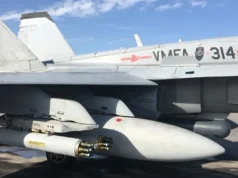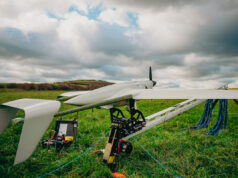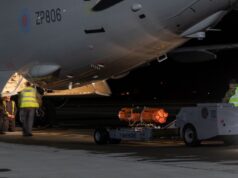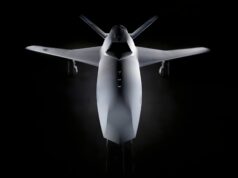The Ministry of Defence’s E-7 Wedgetail airborne early warning programme has been assessed as “Red” in the latest Government Major Projects Portfolio update, reflecting continued challenges with schedule, budget and certification, the UK Defence Journal understands.
According to the NISTA Annual Report 2024–2025, the Delivery Confidence Assessment (DCA) for the programme remained at Red in the fourth quarter of financial year 2024–25, unchanged from the previous year.
The report explained: “The Project’s Delivery Confidence Assessment rating at 24/25-Q4 is RED, compared with the Infrastructure and Projects Authority’s assessment last year of RED. This is due to the following factors. Whilst a sufficient budget was issued to the SRO, the delay in obtaining final approval of the Full Business Case is impacting across several areas of the Programme, particularly the sustainment contract.”
The report also confirmed that the programme’s forecast end date has slipped.
“Compared to financial year 23/24-Q4, the project’s end-date at 24/25-Q4 increased from 01/06/2027 to 31/12/2027. This is primarily due to the following factors. Challenges within the global supply chain, retention of an appropriately skilled workforce at the modification facility and an increase in certification complexity and requirements has caused delays to the In-Service Date and subsequent milestones. As the aircraft completes its modification, the certification schedule is emerging as the critical path.”
The E-7 Wedgetail is intended to provide what the MOD calls a “fifth-generation Airborne Early Warning and Control (AEW&C) capability, with a Multi-role Electronically Scanned Array sensor, interoperable and interchangeable with key allies,” with an anticipated out-of-service date of at least 2042.
Budgetary pressures have also been noted. The report stated: “The budget variance exceeds 5%. This is primarily due to the following factors. Defence financial challenges and internal spend commitment controls have led to a different spend profile to that initially envisaged.” The departmentally agreed whole life cost of the programme decreased from £2.053 billion in FY23/24-Q4 to £1.962 billion in FY24/25-Q4, described as “primarily as a consequence of programme contextual changes in the aircraft acquisition contract.”
Despite the scale of the investment, the report notes: “Compared to financial year 23/24-Q4, the project’s departmentally agreed Benefits at 24/25-Q4 (measured in £m) remained at 0. This is primarily due to the following factors. No monetised benefits.”
The E-7 Wedgetail programme, intended to replace the retired E-3D Sentry fleet, is now not expected to achieve full operational capability until late 2027.














Have we still got those bull Dozers ?
I mean how?
Second hand airframes and an electronics system already in service elsewhere.
Someone is scamming us over this contract.
I think you are making a heap of assumptions here. Currently they are working on the first one. Let’s be generous and contemplate the possibility that time and price have simply been underestimated.
One thing that worries me is “retention of skilled workforce”.
If people are leaving, why? If there is a brain drain going on in this project someone somewhere has taken their eye off the ball.
There is also the suggestion of requirements being changed. If that is so it might be that folk trying to get the job done are getting hacked off with changes to the requirements from the MoD / RAF only to find themselves being expected to finish stuff for the same price in the same timeframe… Therefore they be seriously p*****d off and walk.
Military officers are usually only in post for two years no where near enough time to get up to speed on a complex program such as this, even if it has been down elsewhere. Fiddling around with requirements is often seen as a ‘good’ way to make an impact in post to spice up annual reports. I’ve actually come across this myself.
Complex project should attract a much longer posting and the annual reports should focus on keeping the project on time and to budget. Overspend and/or time slippage should attract a lot of the wrong kind of attention to focus minds…
Cheers CR
A bit like the promised submarines,10 Yr project
NISTA Asses all projects as red until after they are complete.
It’s just one more way the civil service pisses money up the wall for zero effect.
Seriously for a major multi year project what does a colour code even mean. What amount of information could than tell anyone.
It’s just click bate for the media.
That’s because MOD projects are in general run terribly. When’s the last one that was on budget and on time?
Oh, what a surprise. Yet another U.K. success story.
No surprises here. A large military project has slipped slightly in time and cost. I’m sure there is a contingency fund.
The fact that it is highlighted is a good thing – a little extra focus might even prevent further delay.
Get it sorted and out of the red.
*Large* ?
It’s 3 icle weeny teeny old AirLiners.
“You wouldn’t run a business like that”.
Lol. Great we are all expecting you to bid for the work on the next batch.
Working out of your shed you should be able to put in an extremely competative price and still get a little profit.
This could revolutionise defence spending in the UK.
Halfwit Enterprises Ltd?. I’ll look out for you on the stock exchange.
Ha, funny you should mention my Shed, thats exactly where it started, in my shed 1977. Retired now, spend too much time reading silly things on sites like this but find it hugely entertaining.
Any luck with the “Large!” question yet ? or will your assumptions get the better of you again ?
🤡
Across Government there are many projects which can be described as small, medium or large.
In defence large projects are where a good proportion of the money goes. Whilst Boeing might be the prime contractor the work has been subbed out to a UK plant whose people probably had limited access to people who worked on the original design of that aircraft and limited skills dong that type of work.
Sticking a large appendage on top of any plane is going to have various consequences. At the end of the day Boeing need to own any issues and do what it takes to sort them out. I think it might be true to say that Boeing have much to worry about at the moment and the MOD relationship guys should be in overdrive at the moment – which the RED status tells me they probably are.
I’m sort of sticking with large by they way although medium large might be argued. I suspect it is more complex than it appears. It needs to be safe to fly for the next 30 or 40 years. In theory they should be just folowing what has been done before.
Morning Mark, thanks for the half reply, to me 3 airframes can never be described as a Large Project in the way we see other Large projects but I get what you are trying to say.
For me a Large project is a Field full of Solar Panels rather than a Shed rooftop full.
This Project has been ongoing for over two decades when you consider the Australian contract, that’s why I’m calling it out.
How on this planet have proven airframes with systems that are already in service elsewhere, been allowed to slip to this category
MOD procurement again has proven itself to be totally inept.
3 AIRFRAMES for gods sake.
TOTAL AND UTTER INCOMPETANCE
You do know the MOD don’t do this work in-house?
The mere fact that the project is in the RED category is proof they are keeping an eye on it and hav acted to correct the issue.
We could perhaps query the choice of contractor or maybe the allocated budget. Modifying existing aircraft is perhaps not an easy task and may not be within the skill set of many companies.
Somebody somewhere is trying to fk this country through selling off good ships, not accepting people in the forces for crap reasons, not getting new kit and spending our money on hotels for isis fighters….
Different day, different programme, same old shit same old excuses.
“As the aircraft completes its modification, the certification schedule is emerging as the critical path.”
Do I smell post Haddon Cave processes rearing their head again?
The problem with procuring just three frames is that #1-3 is the learning curve and #4-5+ is then handle turning.
So none of the learning curve monies are utilised properly.
I’m not too surprised that it was hard to keep skilled people a couple of years ago when the jobs market was red hot. I would be very worried if it was the case now as things have cooled so much.
The Australian order had lots of delays and issues too going back to 2004 and beyond, it seems par for the coarse.
How would this have gone as a new build? One of the problems with second hand is variations over time. Not a problem until you try to slice & dice. These are not standard 737-700. They are BBJ 737-700, so the odd one here & there against hundreds of standard B737-700 aircraft.
If they’d wanted a new build they would have had to go for a 737-MAX as the NGs are no-longer manufactured. Using MAXs would have
• increased their divergence from the other Wedgetails in service internationally,
• would have reduced commonality with other 737s in RAF service (eg P8 Poseidon), and….
• are we 100% confident all the issues in the MAX bodge have been discovered and rectified??
If the in service date is now 2027, and the OSD is 2042, they look as if they will only last for 15 years…………?
Nothing new in the report and I am afraid to say it was all predictable at the time of contract signature. Second hand airframes were always going to cause issues because of the post Hadden Cave certification regime. The subcontractor is inexperienced in this type complex defence work and had to build up its workforce to do the job and retain it over the period of only 3 conversions. The danger signs were there when Marshalls pulled out of the project and they are perhaps the only UK company used to this type of military conversion work. The Mission system must have presented problems because it was some years since the RAAF systems were built and some high spec components will have been difficult to source and their replacements may have necessitated some knock on changes to existing systems. Lastly wonder if Boeing as the prime contractor has they put the necessary ‘A team’ together with NG to support not only the conversions but also the complex system testing required for this type of aircraft. Do they have a systems integration rig in their factory staffed by experienced programmers able to quickly detect and fix software problems which are inevitable in this type of system which will emerge as the mission system is put through its paces. When the E3s were developed Boeing built a very large team at their Integration Lab at Seattle and even with that facility and its substantial budget, delays were experienced.
Can anyone say Nimrod…..
With the US pulling out of this project it leaves the UK basically stuffed.
The UK E7 is not another Nimrod AEW. Its radar has been proven to work operationally and the associated mission system has been guided by the RAAF and works well for them. The Nimrod AEW radar didn’t work despite some uninformed claims and its mission system was shoehorned into the comet airframe and even if the radar could have been made to work (unlikely) the mission system was likely to have been a major constraint on future upgrades. The B737 is the best airframe available and the radar has been harmonised with the airframe and proven to work well. The use of second hand airframes was a questionable decision but any other derivative of the B737 or a new airframe would have extended the programme and have cost more but may have avoided some of the likely certification issues. Use of the P7 airframe might have been a better option and would have had the advantage of considerably more up to date documentation and a current Boeing team working on the military version. What is similar to the Nimrod is the UK’s inability to properly determine the cost and timescales of such complex systems. Often these are driven by the desire to buy something the Defence budget cannot afford and a belief that cost saving by the use of second hand airframes was the answer. The use of of an inexperienced (in military conversions) UK subcontractor was always problematic and Boeing were responsible for that. But I get the feeling that the desire by some in the MOD/RAF to scrap the E3s was made before proper in depth analysis of the UK E7 option was carried out and scrapping the E3 decision was made and announced before the necessary home-work on the E7 offering was carried out. This has put more pressure on the UK programme which could have been avoided and I bet been popular with RAF operators, if not the MOD/RAF seniors who took the decision to take an ‘AEW holiday’. This has now been extended by an additional 2 years but of course the seniors involved in that decision have now moved on and someone else is having to deal with the fallout. Despite all of this, the E7 is a very capable and much needed aircraft for the RAF. If Boeing can bring the full weight of their capability to make a success of the programme it will then put them in a good position for a NATO order and hopefully the USAF E7 programme is not is not quite dead yet because a space based solution is years away and unlike the uk, the USAF cannot afford to take an AEW holiday as an AWACS capability remains key to their airspace control doctrine.
Excellent article and wholly true. UK Defence using an inexperienced team on a new project, underfunded from the start. South Korea have 4 with MESA, RAAF have (7?) (without MESA) and Turkey have their own version, 4 in number, we can’t get one in the sky working on time or within budget. And we sold off our AWACS to NATO cheap before we had a suitable replacement with any chance of being on time. All of this lead to UK being in a position unable to defend it’s own skies.